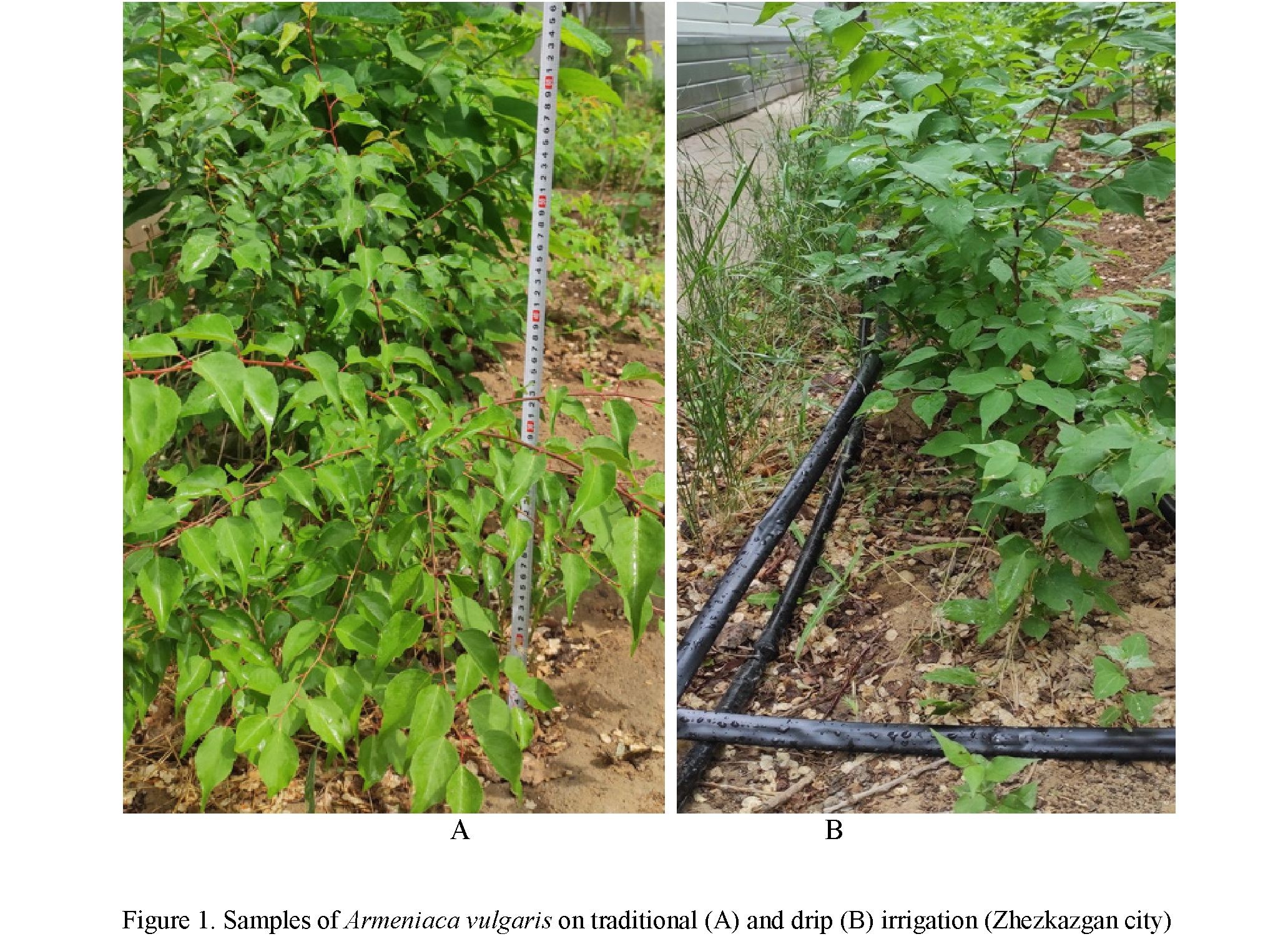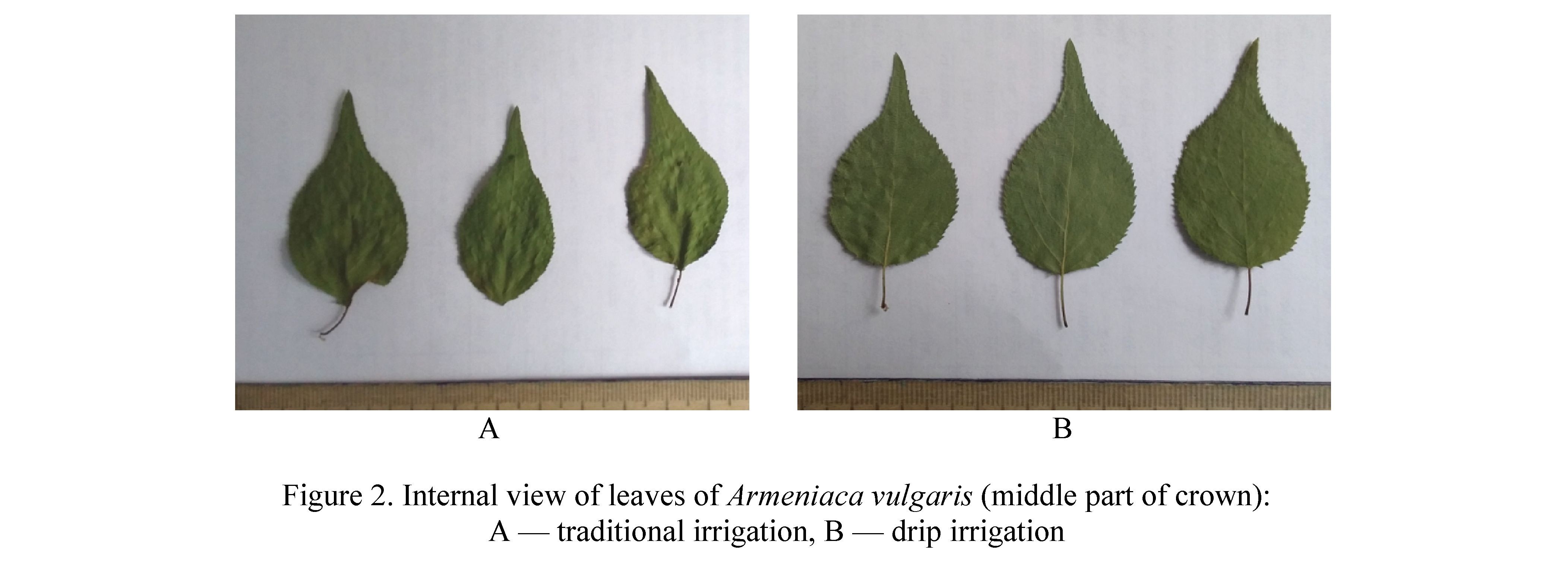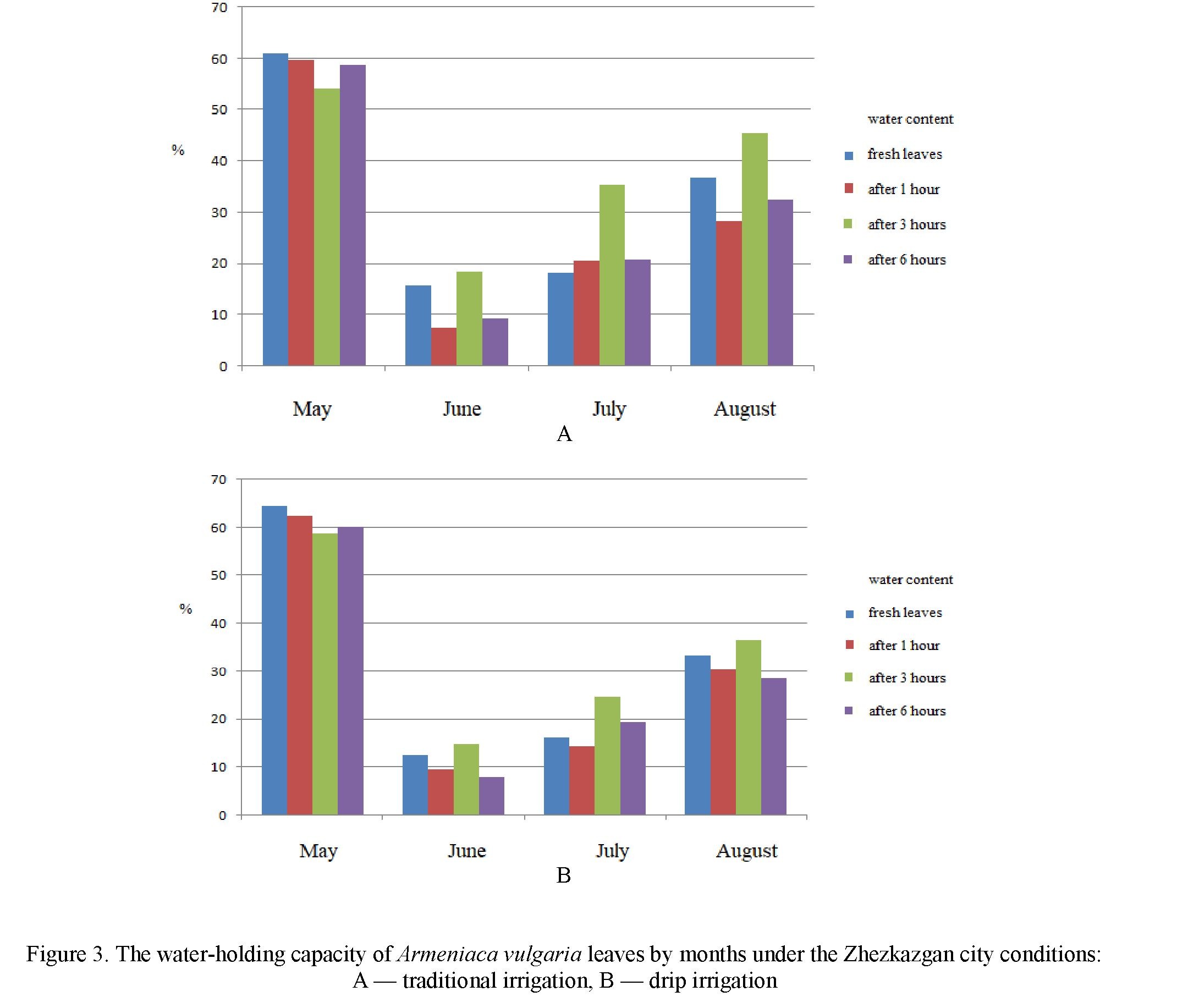The expansion of the existing range of tree crops for the greening of settlements is of practical and environmental importance. In the Zhezkazgan industrial region it is necessary to select plants that are resistant to heat, drought, low temperatures and atmospheric pollution, which limits the species composition. In present article studies are conducted to assess the water content in the leaves of Armeniaca vulgaris Lam. during the vegetation season under growing using traditional furrow watering and drip irrigation. The assessment of leaf water content showed maximum parameters in May, a decrease in June and July, and repeated increase in August of 2020–2021. Minimum indicators of water-holding capacity are noted in May, maximum — in June. Leaves of plants grown on drip irrigation had parameters of water-holding capacity 1.3–3.9 % higher than under the traditional irrigation method, which indicates a better moisture supply. In general, the water content of apricot leaves was above 50 %, which shows sufficient water supply. The results showed the resistance of Armeniaca vulgaris plants to heat and drought, so, this species is recommended for use in green construction of the Zhezkazgan industrial region.
Introduction
The formation of a modern green building assortment plays an important role in the urban environment, especially for settlements located in industrial contaminated centers and in arid conditions [1–3]. Zhezkazgan industrial region is characterized by extra-arid conditions, a lack of precipitation, high summer temperatures and low temperatures in winter. Therefore trees and shrubs for introduction into landscaping in the urban environment should be characterized by heat resistance, winter resistance and resistance to industrial pollution [4, 5].
The assortment of green spaces of the Zhezkazgan and Balkhash industrial regions is represented by a small number of species: Ulmus pumila, Ulmus pinato-ramosa, Acer negundo, Caragana arborescens, Ribes aureum, Malus baccata, Populus nigra, Populus pyramidalis, Elaeagnus oxycarpa, Syringa josikaea, Crataegus sanguine, Pinus sylvestris and other [6, 7].
Among perspective species for future cultivation in Zhezkazgan and Balkhash cities is Armeniaca vulgaris, which features high decorative qualities, rapid growth, frost resistance, tolerance of high summer temperatures and air pollution [8–10].
An important condition for the heat resistance of plants under arid conditions is the water-retaining ability, that is, the ability of plants to retain moisture in the summer [11, 12]. One way to solve the problems of increasing resistance to arid conditions is to organize satisfactory irrigation [13, 14]. Therefore, studies are needed to assess the physiological indicators of trees against the background of different irrigation methods.
International experience shows the prospect of drip irrigation in the urban environment, which saves water and maintains the stability of the different crops [15–17].
The purpose of present study is to consider the water-holding capacity of leaves of Armeniaca vulgaris grown on traditional watering and drip irrigation in the conditions of the Zhezkazgan region.
Materials and methodology
Object of study is young plants of apricot (Armeniaca vulgaris Lam., or Prunus armeniaca L., Rosaceae family). Apricot is usually a small tree from 5 to 12 meters high, a large shrub is rare [18]. Vegetation duration is 50–100 years that depends on the climate and cultivation conditions. Shoots of apricot are red-brown or greenish-brown, glabrous, shiny, sometimes covered with gray film. The root system is deep. The buds are located on 2–3 pieces. The sheet is simple, oval, with an elongated pointed tip, 4–12 cm long, with a serrated edge. The flower is large, white-pink, fragrant, blooms before the opening of leaves. The fruit is a drupe, yellow or orange, fleshy, semi-fleshy or dry, usually pubescent and velvety to the touch. Fruiting occurs from 3–5 years.
Leaves of Armeniaca vulgaris are taken from 2-year trees (a middle part of crown) growing at the nursery in Zhezkazgan in May-August 2020–2021 (Fig. 1); separately from plots with traditional (superficial by borowa) and drip irrigation (diameters of fleets 20 mm) [19]. The watering rate in both versions of the experience was 1.5 m3 per season with a number of waterings at least 10 [20].
Leaf sizes were evaluated during full deployment (June), leaf area is evaluated by weighted area methods. From May to August, the water retention capacity of the leaves was assessed by measuring weight after 1, 3, and 6 hours [9, 21, 22].
The results of 2-year observations are combined and processed statistically using online system www.medstatistic.ru.
Results and discussion
The growing season in Zhezkazgan is tense due to arid conditions, frequent dry winds and low relative humidity [23]. Tree-shrub plants experience the greatest moisture deficiency from the end of June to midAugust [24].
Visual observations of apricot leaves showed that the strongest negative effects are observed in July, 2021. Partial yellowing of the leaves of the upper part of crow, burns, single fall are observed. Leaves of the middle and lower part of the crown practically did not change in appearance.
Under different irrigation conditions, reliable differences in size and area of apricot sheet plates are observed (Fig. 2, Tab. 1).

The morphological parameters and square of leaf sheets of Armeniaca vulgaris depending
on method of irrigation in the conditions of the Zhezkazgan region
|
Method of irrigation |
Sheet length, cm |
Sheet width, cm |
Length of sheet petiole, cm |
Square of sheet plate, 3 cm |
|
Traditional irrigation |
5.3 ± 0.6 4.5 — 6.0 |
2.97 ± 0.29 2.5 — 3.4 |
1.18 ± 0.16 1.0 — 1.5 |
11.48 ± 1.61 9.2 — 14.8 |
|
Drip irrigation |
6.6 ± 0.5 6.0 — 7.4 |
4.07 ± 0.31 3.5 — 4.7 |
1.54 ± 0.10 1.4 — 1.7 |
20.40 ± 1.97 18.0 — 25.1 |
|
*in a numerator — M±m; in a denominator the maximum and minimum value of an indicator |
||||
Table 1
So, in length, plant leaves on drip irrigation turned out to be by 1.3 cm bigger than with traditional irrigation; by the width of the sheet — by 1.1 cm, by the length of the petiole of the sheet — by 0.36 cm, by the area — by 8.92 cm3.
During the growing season the water content of apricot leaves ranged from 54.3 to 64.6 % by fresh weight (Tab. 2).
The water-holding capacity of Armeniaca vulgaris leaves depending on
method of irrigation in the conditions of the Zhezkazgan region
|
Method of irrigation |
Month |
Water content, % |
Loss of moisture during jamming through, % |
||
|
1 hour |
3 hours |
6 hours |
|||
|
Traditional irrigation |
May |
61.1±2.0 |
15.8±0.5 |
18.2±0.3 |
36.9±1.2 |
|
June |
59.6±2.2 |
7.5±0.4 |
20.5±0.7 |
28.3±0.8 |
|
|
July |
54.3±0.9 |
18.6±1.0 |
35.4±1.6 |
45.6±1.5 |
|
|
August |
58.9±1.6 |
9.4±0.4 |
20.8±0.8 |
32.4±1.4 |
|
|
Drip irrigation |
May |
64.5±0.6 |
12.6±0.6 |
16.2±0.4 |
33.5±1.6 |
|
June |
62.4±0.5 |
9.5±0.8 |
14.5±0.5 |
30.4±1.6 |
|
|
July |
58.8±1.1 |
14.8±1.2 |
24.6±0.6 |
36.5±1.3 |
|
|
August |
60.1±2.1 |
8.1±0.5 |
19.5±0.8 |
28.5±0.6 |
|
Table 2
The reduced moisture content is noted in the traditional irrigation method, which indicates that moisture loss occurs. On drip watering, the plants received more water.
The water content and water-holding capacity of the leaves of Armeniaca vulgaris varied on different month. So, in May, the leaves had maximum humidity, which is due to the lower temperatures and higher relative humidity of the spring period [25]. However, water losses in apricot plants were higher in May than in June. This aspect is explained by the fact that the leaves are young, not adapted to drought. In June, the water content of the leaves was lower, but the mass when dried is less (Fig. 3). Apparently, adult apricot leaves more easily adapted to drought, better kept it in the flesh.
Серия «Биология». № 3(103)/2021
51

The minimum moisture content of apricot leaves is noted in July, characterized by maximum temperatures and minimum relative humidity. This affects the water retention capacity, which was minimal for all types of irrigation and all test indicators by month.
In August the water content in the leaves was higher than in July due to a decrease in air temperature and precipitation. It was also recorded that the moisture loss during drying was minimal. A comparison of the results of the studies showed the adaptive reaction of apricot leaves in all variant of observation to prolonged dehydration.
In general, the moisture content of apricot leaves above 50 % indicates sufficient watering, although more moisture is obtained by drip irrigation of plants. The water content and weight loss during drying in plants on drip irrigation turned out to be higher than in plants on traditional watering. The monthly difference ranged from 1.3 to 3.9 % in favor of drip irrigation efficiency.
Thus, the indicators of water content and water retention ability indicate sufficient drought resistance of ordinary apricot in the conditions of Zhezkazgan, which allows us to recommend it for green construction.
Conclusion
A study of the water content and water retention of the leaves of Armeniaca vulgaris showed that in spring and late summer the moisture content was higher than in early and mid-summer. The water content of the leaves during the studied vegetation season was higher than 50 %, which indicated a sufficient rate of watering.
52
Вестник Карагандинского университета

In the process of vegetation, a change in the water retention ability is observed. Maximum indicators are noted in June, minimum — in May. The water content of apricot leaves was higher for plants grown on drip watering, and the leaves lost less moisture when dried. The obtained indicators signity positive effect of drip irrigation.
The obtained data on apricot show its good resistance to summer conditions in Zhezkazgan city, so this species should be recommended for introduction into green building.
Acknowledgement
The article is prepared accordance with Grant Project of Science Committee of the Ministry of Education and Science (AP09562730 «Development modern technology for growing nontraditional planting material in closed and open ground in arid conditions of the Karaganda region»).
- Giyasov, A. (2019). System of greening of urban spaces and its role in optimization of the micro- and bioclimate environment. Web of Conferences, 135; Article ID. https://doi.org/10.1051/e3sconf/201913503060
- Sturiale, L. & Scuderi, A. (2019). The role of green infrastructures in urban planning for climate change adaptation. Climate, 7 (10); 2–24. https://doi.org/10.3390/cli7100119
- Alekseeva, I., Menshikh, D. & Kudryavtseva, O. V. (2016). Greening as an element of sustainable urban development: valuation of economic feasibility, policy assessment and practical examples. Vestnik RUDN. Seriya agronomiya i zhivotnovodstvo — Bulletin of Russian University of People Friendship. Series Agronomy and Animal Husbandry, 4; 51–62. https://doi.org/10.22363-2312- 797X-2016-4-51-62
- Baitulin, I.O. (2010). Teoreticheskie osnovy i metodicheskie podhody k introduktsii rastenii v regionakh s ekstremalnymi klimaticheskimi usloviiami [Theoretical foundations and methodological approaches to plant introduction in regions with extreme climatic conditions]. Izvestiia NAN RK. Seriia biologicheskaia i meditsinskaia — proceeding of National Academy of Science. Series biological and medical, 2 (278); 18–25 [in Russian].
- Glibovytska, N. I. & Karavanovych, K. B. (2018). Morphological and physiological parameters of woody plants under conditions of environmental oil pollution. Ukrainian Journal of Ecology, 8 (3); 322–327.
- (1974). Assortiment dekorativnykh rastenii dlia ozeleneniia Dzhezkazganskogo promyshlennogo raiona [Assortment of decorative plants for greening of Dzhezkazgan industrial region]. Alma-Ata [in Russian].
- Akhmetov, М.K. & Maksutbekova, G.T. (2017). Otsenka sovremennogo vidovogo sostava i sostoianiia zelenykh nasazhdenii Zhezkazganskogo regiona [Assessment of the modern species composition and state of green spaces of the Zherkazgan region]. Integratsiia nauki — Integration of science, 9 (13); 111–115 [in Russian].
- Markovskaya, V., Dmitriev, P., Kozlovsky, B., Varduny, T., Kupriushkin, D.P. & Chokheli, V.A. (2019). Catalpa speciosa (Warder ex Barney) Warder ex Engelm. and Armeniaca vulgaris Lam. in the space of vegetation indices CARI, CRI2, CSI5. Zhivye i biokosnye sistemy — Living and Biocos Systems, 27. URL: http://www.jbks.ru/archive/issue-27/article-9
- Pil'kevich, R.A. (2008). Osobennosti vodnogo rezhima gibridov Prunus brigantiatsa Vill. x Armeniaca vulgaris Lam. selektsii Nikitskogo botanicheskogo sada [The peculiarities of water regime of hybrids Prunus brigantiaca Vill. x Armeniaca vulgaris Lam. of the selection of Nikitskii Botanical Garden]. Trudy Nikitskogo botanicheskogo sada — Proceedings of Nikitskii Botanical Garden, 129; 87–99 [in Russian].
- Ibragimova, E.E. (2010). Vliianie tekhnogennogo khimicheskogo zagriazneniia na velichinu fluktuiruiushchei asimmetrii listovoi plastinki Armeniaka vulgaris Lam. [Influence of technogenic chemical contamination on the fluctuating asymmetry of Armeniaca vulgaris Lam. leaf plate]. Uchenye zapiski Tavricheskogo natsionalnogo universiteta imeni V.I. Vernadskogo. Seriia biologiia, khimiia — Scientific notes of the Tauride National University named after V.I. Vernadsky. Biology, Chemistry Series, 23 (62), 3; 62–67 [in Russian].
- Imanbayeva, A.A. & Belozerov, I.F. (2019). Nekotorye fiziologicheskie indikatory ustoichivosti drevesnykh rastenii v aridnykh usloviiakh pustyni Mangistau [Some physiological indicators of resistant of woody plants in the arid conditions of the Mangystau desert]. Sadovodstvo i vinogradarstvo — Gardening and viticulture, 3; 13–26. Retrieved from https://doi.org/10.31676/0235-2591-2019-3-13-26 [in Russian].
- Hinckley, T.M. & Ceulemans, R. (1989). Current focuses in woody plants water relations and drought resistant. Ann. Sci. For., 46, suppl.; 317–324.
- Christen, E., Ayars, J., Hornbuckle, J. & Hickey, M. (2006). Technology and practice fir irrigation in vegetable. Yanco, Australis.
- Сhai, Q., Gan, Y., Zhao, C., Xu, H. -I., Waskom, R. M., Niu, Y. & Siddique, K. H. M. (2015). Regulated deficit irrigation for crop production under drought stress. A review. Agron. Sustain. Dev., 36, 1; 1–22. https://doi.org/1007/s13593–015–0338–6
- Capra, A. & Scicolone, B. (2006). Recycling of poor quality urban wasterwater by drip irrigation system. Journal of Cleaner Production, 15; 1529–1534. https://doi.org/10.1016/j.jclepro.2006.07.032
- Ouedraogo, S.K. L., Kebre, M.B. & Zougmore, F. (2021). Water dynamics under drip irrigation to proper manage water use in arid zone. Journal of Agricultural Chemistry and Environment, 10; 57–68. https://doi.org/10.4236/jacen.2021.101004
- Usman, K.H., Muhammad, T., Majid, M., Ali, S. M., Shilan, R., Alireza, M. & Plygun, S. (2016). Drip irrigation in Pakistan: status, challenges and future prospects. Rossiskii zhurnal selskokhoziaistvennykh i sotsialno-ekonomicheskikh nauk — Russian Journal of agricultural and social-economic sciences, 8 (56); 114–126. https://dx.doi.org/10.18551/rjoas.2016–08.15
- Avdeev, V.I. (2012). Abrikosy Evrazii: evoliutsiia, genofond, introduktsiia, selektsiia [Apricots of Eurasia: evolution, genetic fund, introduction, select breeding]. Orenburg: Orenburg State University [in Russian].
- (2020). Kapelnyi poliv. Prodvizhenie agrotekhnologii, sodeistvuiushchikh adaptatsii k izmeneniiu klimata v usloviiakh pustynnoi zony Zhezkazganskogo regiona [Drip watering. Promoting agro-technologies that facilitate adaptation to climate change in the desert zone of the Zhezkazgan region]. Zhezkazgan: The Small Grants Programme [in Russian].
- Maksutbekova, G.T., Ishmuratova, M.Yu. & Akhmatov, M.K. (2017). Rekomendatsii po sozdaniiu i ukhodu za zelenymi nasazhdeniiami v usloviiakh Zhezkazganskogo promyshlennogo regiona [Recommendations for the creation and care of green spaces in the Zhezkazgan industrial region]. Zhezkazgan: ZhezU [in Russian].
- Lishchuk, A.I. (1991). Metodika opredeleniia vodouderzhivaiushchei sposobnosti k obezvozhivaniiu listev plodovykh kultur [Procedure for determination of water-retaining capacity for dehydration of fruit crop leaves]. Fiziologicheskie i biofizicheskie metody v selektsii plodovykh kultur: Metodicheskie rekomendatsii — Physiological and biophysical methods in the selection of fruit crops. Methodological recommendations. Moscow, 33–36 [in Russian].
- Lishchuk, A.I. & Pil'kevich, R. A. (1999). Polevoi metod otsenki ustoichivosti k zasukhe i vysokim temperaturam [Field method for assessing resistance to drought and high temperatures]. Intensifikatsiia selektsii plodovykh kultur — Intensification of select breeding of fruit cultures, 118; 113–116 [in Russian].
- Urumov, T.М. (1994). Kratkaia geograficheskaia i klimatologicheskaia kharakteristika Zhezkazganskogo promyshlennogo raiona [Brief geographical and climatological characteristics of the Zhezkazgan industrial region]. V knige Bolshoi Zhezkazgan — In book Great Zhezkazgan. Almaty: Poligraphkombinat, 14–16 [in Russian].
- Ishmuratova, M.Yu., Tleukenova, S.U., Dodonova, A.Sh. & Gavrilkova, H.A. (2013). Study of Water-holding Indicators of Various Environmental Groups of Trees and Shrubs under Zhezkazgan Region Conditions. European Researcher, 49, 5–2; 1298– 1303.
- Kushnirenko, M. D. (1967). Vodnyi rezhim i zasukhoustoichivost plodovykh rastenii [Water regime and drught-resistant of fruit plants]. Kishinev [in Russian].